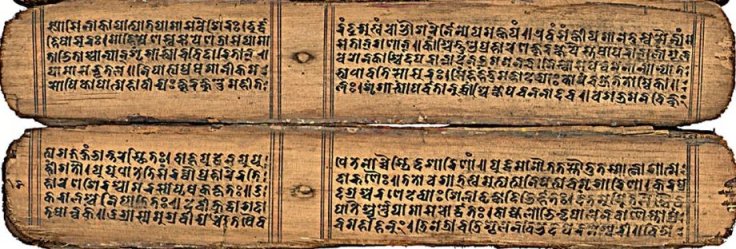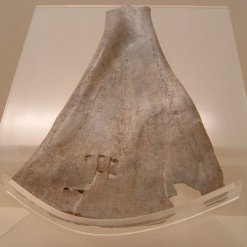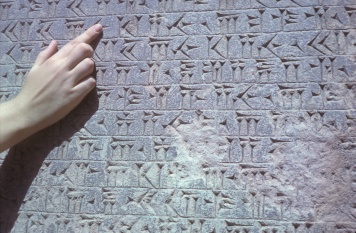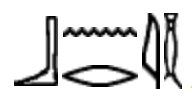For this installment of the “Languages of the World” series, we’re doing something a little bit different. Normally, I focus on one single country and explore all the languages spoken there, but today, we’re building a time machine and heading to a time period to explore all the languages spoken then.
Welcome to ancient times!
While the time period of ancient times can be pretty expansive, we’re going to focus on the time period between 4000 BC to roughly 500 AD. During this time, civilizations rose and fell: the kingdoms of Mesopotamia, the Egyptians, the Greeks, the Chinese, the Indus Valley Civilizations, and the Roman Empire. Like today, each kingdom spoke its own language—sometimes multiple languages. In fact, with the use of the Silk Road around 120 BC, multilingualism or (at the very least) knowledge of foreign languages spread throughout the world.
So, what were the languages spoken during this time? Let’s check them out!
Greek
The first language on our list, Ancient Greek, is thought to be 5000 years old. In fact, Greek has the longest recorded history with its oldest text (the Linear B clay tablet) dating back to 1350 BC.

The first Linear B tablet was found in Crete in 1886, and it gave linguists a glimpse into what Ancient Greek sounded like almost 3500 years ago. More interestingly, a second clay tablet showing a writing system called Linear A has also been found, and it is thought to date back to 2500 BC. The only problem? We can’t figure out what Linear A says, and it remains undeciphered to this day.
 Sometime around the 9th century BC, the Greek language abandoned the scripts used on Linear B and instead adopted earliest carnations of the alphabet that Greek is written in today. In fact, that alphabet is a descendant of the Phoenician alphabet (ie. the oldest recorded alphabet in the world).
Sometime around the 9th century BC, the Greek language abandoned the scripts used on Linear B and instead adopted earliest carnations of the alphabet that Greek is written in today. In fact, that alphabet is a descendant of the Phoenician alphabet (ie. the oldest recorded alphabet in the world).
Due to this, we can compare what Ancient Greek may have sounded like in comparison to today. For example, Ancient Greek differs from modern Greek because it allowed for a dual number in addition to singular and plural.
Most interestingly, over 100,000 Greek words have been borrowed into modern English, mostly in the field of science.
Latin
The second languages on our list is a close geographical friend to Ancient Greek: Latin. The first written accounts of Latin date back to 1000 BC, and it has been used continuously in some capacity since then.

During ancient times, Latin was the official language of the Roman Empire, also known as one of the most expansive languages of the ancient world. It would go onto to evolve into Vulgar Latin (which doesn’t have anything to do with swear words…). Vulgar Latin was just the vernacular spoken by everyday people, and this language would evolve into the modern Romance languages we see today: French, Italian, Spanish, Portuguese and Romanian.
Even today, Latin is highly inflected, giving it a relatively free word order in comparison to other Indo-European languages. It has three genders, seven cases, and six tenses. While Latin is technically a dead language, meaning that no one actually speaks it natively or uses it in every day, it is still an official language of Vatican City, and it remains used in its religious ceremonies.
Furthermore, Latin-based words (or words originating from Latin-based Romance languages) make up an astounding 59% of the English language.
Arabic
The first attested account of Arabic dates back to the 9th century BC in ancient Assyria. These first inscriptions were simply personal names, but full inscriptions date back to about 400 BC.

During this time, Arabic didn’t have a single script. It was written in many scripts (even the Greek alphabet at one point!), and it wasn’t until about 400 AD that Arabic used the Arabic script we have today. Like Greek, the earliest carnation of the Arabic alphabet was adapted from the Phoenician alphabet.
Today, Modern Standard Arabic is the written form of the language, but not many people actually speak Modern Standard Arabic. In fact, there are almost 26 dialects of Arabic: each Arab country speaks its own dialects or multiple dialects of the language. Further, there are approximately 270 million native Arabic speakers in the world and some 1.7 billion people use Arabic as a religious language for Islam.
Hebrew
A language that is related to Arabic is none other than its fellow Afro-asiatic language and Semitic languages Hebrew. While the two languages are related, there is almost zero mutual intelligibility between the two. To be honest, I don’t speak either language, so I can’t verify that for sure, but if you do speak on of these languages, let me know if that’s true in the comments below.

Hebrew was a widespread language in the Kingdom of Israel and Judah between 1200 and 586 BC. The earliest inscription of Hebrew has been found at an archaeological site called Khirbet Qeiyafa in the Elah Valley (Israel), and it is an inscription on a jar that dates back to around 1000 BC.
Interestingly, Hebrew completely stopped being used as a spoken language around 400 BC, surviving mostly in religious practices and texts. Due to the rise of Zionism in the 19th century, Hebrew experienced a revival, and today it is spoken by about 10 million people and it is an official language of Israel. Furthermore, Hebrew is the only living language of the Canaanite language family that is still spoken today.
Sanskrit
Heading to the Indus Valley now, Sanskrit was one of the primary first languages of India. The earliest written account of Sanskrit is from the “Rig Veda” hymns, a collection of religious texts that date back to 3000 BC.

While Sanskrit is thought to have died completely in a spoken context in 600 AD, it has experienced a slight revival in modern times, like Hebrew. Efforts to preserve the language have led to a supposed 14,000 speakers of Sanskrit who live in India according to the 2001 Indian census.
While this number is hard to verify, it doesn’t seem unlikely that Sanskrit survives in some form. It has been used as a religious language for centuries and its extensive collection of literature is quite impressive for an ancient language.
Chinese
According to some estimates, Chinese is the oldest language in the world. While most scholars say that it originated in 2000 BC, some date it back to 8000 BC or even 10,000 BC. If these estimates were ever verified, that would make it the oldest continuously spoken language in the world.

Nonetheless, Old Chinese experienced great use during the Zhou Dynasty between 1122 BC and 256 BC. These written accounts were found on “Oracle Bones”, shards of ox bones with Chinese inscriptions.
During this time, Mandarin emerged as the standard dialect throughout the Chinese empire. Despite this, many other variations of Chinese continued to exist and are still spoken today. It is estimated that there are hundreds of variants of Chinese presently on Earth.
Speaking of these variants, while they are all labelled “Chinese”, there is some contention in the linguistic community as to whether or not Chinese is even a real language or rather a group of mutually unintelligible languages. According to most theories, Chinese is an umbrella term that refers to the Sino-Tibetic languages, a topic you can see discussed in my video entitled “The Languages of China”.
Related: Languages of CHINA (Languages of the World Episode 7)!
Sumerian & Akkadian
Sumerian and Akkadian are grouped together on this list because they are in fact two very close languages. I don’t mean “close” as in “related”, in this case (Sumerian is a language isolate, and Akkadian is a Semitic language). I mean to say that these two languages are more like buddies: they were spoken literally side-by-side.

Sumerian was spoken in ancient Sumer (modern Iraq) from 3000 BC to 100 AD, and Akkadian was spoken in the Akkadian Empire from 2500 BC to 100 AD in practically the same region. Fun fact: two variants of the language were Babylonian and Assyrian.
These languages were so close that actually created what is known as a Sprachbund. In linguistics, a Sprachbund is an area of linguistic convergence where two languages borrow words and grammatical structures from each other, giving us the false idea that two languages may be related. In fact, Sumerian and Akkadian became so alike at one point that they even shared the same writing system (Akkadian cuneiform), with modifications made for the Sumerian language.
Persian (Farsi)
Persian, or Farsi as it is known to its speakers, is an Indo-Iranian language, meaning it is related to languages like Hindi and Urdu and even other Indo-European languages like German and English!

The first attested scripts of Persian date back to 500 BC during the First Persian Empire. In fact, the earliest written records such as, for example, the Behistun Inscription, show Persian being written in Old Persian cuneiform, itself originating from Sumer-Akkadian cuneiform.
During and after the Muslim conquest of Persia around 640 AD, however, Persian adopted the Arabic alphabet that we see used today. This also led to the Classical Persian period where Persian became widely used by poets and writers, and Persian in fact became the lingua franca for parts of the Muslim world for a time.
Egyptian
Last but not least, how could we have a list of the languages of the ancient world if we forgot Egyptian?
Egyptian is an Afroasiatic language, meaning it is related to Arabic and Hebrew. The earliest full written account of Egyptian dates to 2690 BC, however the earliest use of single hieroglyphs date back to 3300 BC. In fact, hieroglyphics are completely unique as a writing system in the sense that symbols could represent an entire word, a syllable or a single sound.
![]() For example, the symbol to the left of this paragraph means “sun” (an entire word). However, other symbols, such as the ones below this paragraph, can represent individual sounds. This inscription in particular represents the sounds b, n, r, i which in turn spell the word. “sweet”.
For example, the symbol to the left of this paragraph means “sun” (an entire word). However, other symbols, such as the ones below this paragraph, can represent individual sounds. This inscription in particular represents the sounds b, n, r, i which in turn spell the word. “sweet”.

While Egyptian died out with much of the Egyptian Empire, the language itself evolved into Demotic and Coptic. While these languages are not particularly widely spoken today, Coptic survives as a religious language in the Coptic Orthodox Church of Alexandria.
And there you have it! I know I missed quite a few languages in this list, so if you want a part two, definitely leave a comment below with suggestions!


This is so cool! Also I just wanted to say I love your Russian vlogs, I didn’t start learning Russian long ago but I’m using the same textbook as you and it’s nice seeing someone at a similar stage as I don’t know many Russian learners! How’s your progress going?
LikeLiked by 1 person
It’s funny you ask :p I will be posting another Russian vlog very soon! Thanks for watching, and thanks for commenting 😀
LikeLiked by 1 person
Like Greek in Sanskrit Grammar also there are dual number in addition to singular and plural.
LikeLike
So people started asking you about Tamil and that you should consider.
https://www.indiatoday.in/education-today/gk-current-affairs/story/oldest-languages-839038-2016-12-20
Tamil in the top as Antiquity.
https://en.wikipedia.org/wiki/Classical_language
I saw your video regarding “is Tamil oldest language in the world?” and I noticed you read the exact sentence of Wikipedia! That shows you are not worth of talking about languages. 60% of 1 million written scripts in India are in Tamil language and you don’t think we have written evidence buried somewhere yet to digout. The is a conspiracy among central government (Hindi speakers) and Tamil activists. Lost of unearthed Tamil evidance are locked and closed.
Try to know the meaning of Dravidian Languages (and don’t get it from wikipedia)
I read the following lines on “A Comparative Grammar of the Dravidian Or South-Indian Family of Languages – By Robert Caldwell” – page no 6 (Introduction)
“It thus appears that the word ‘Dravida,’ from which the term ‘Dravidian’ has been formed, though sometimes used in a restricted sense, as equivalent to Tamil, is better fitted, notwithstanding, for use as a generic term; inasmuch as it not only has the advantage of being more remote from ordinary usage, and somewhat more vague, but has also the further and special advantage of having already been occasionally used by Indian philologists in a generic sense. By the adoption of this term ‘Dravidian,’ the word ‘Tamilian’ has been left free to signify that which is distinctively Tamil.”
“By the adoption of this term ‘Dravidian,’ the word ‘Tamilian’ has been left free to signify that which is distinctively Tamil.”
My understanding here is Robert Caldwell found Tamil Language Group in south India, but he don’t wanted to call it Tamilian Language group. Since Tamilian means Tamil People (people who speak Tamil language). So he marked this group of Languages as “Dravidian Languages.” which indirectly means Tamil Languages from his context.
Hence “Dravidian Languages” can be said “Tamil languages” as per Robert Caldwell (or My understanding of, what Robert Caldwell mentioned here is wrong.)
The people trying to say that “Tamil is oldest living classical Language in the World”, in a sense that Sanskrit you mentioned here is Dead a long before!
LikeLike
https://taleninstituut.nl/what-are-the-oldest-languages-on-earth/
http://www.globallanguageservices.co.uk/oldest-languages/
https://theculturetrip.com/asia/india/articles/the-10-oldest-languages-still-spoken-in-the-world-today/
https://www.triphobo.com/blog/oldest-languages-still-spoken
http://www.wipjobs.com/what-are-the-7-worlds-oldest-languages/
These are not evidence for Tamil is oldest language. But when ever talks come about oldest languages of the world Tamil comes in. Got the picture?
Grow up!
LikeLike
What about Aramaic? It’s even older than Hebrew or Arabic!! I’m looking for common language spoken around the ancient world and it’s not included in your list,.
LikeLike